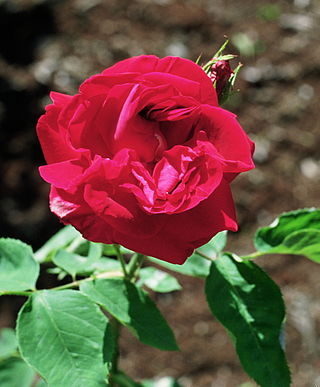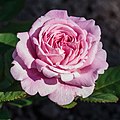
Rosa 'Schoener's Nutkana' is a deep pink rose variety named after Father Georg Schöner (1864–1941), a priest who became a notable rose breeder, who developed this rose in 1930 as a cross between Rosa nutkana and the hybrid perpetual 'Paul Neyron'.

Rosa 'Ispahan', also known as 'Rose d'Ispahan' and 'Pompon des Princes', is a clear pink, half-open kind of Damask rose, a type of garden rose introduced from the Middle East to Europe during the crusading 13th century.

Rosa 'Harison's Yellow', also known as R. × harisonii, the Oregon Trail Rose or the Yellow Rose of Texas, is a rose cultivar which originated as a chance hybrid in the early 19th century. It probably is a seedling of Rosa foetida and Rosa pimpinellifolia. The cultivar first bloomed at the suburban villa of George Folliott Harison, attorney, between 8th and 9th Avenues on 32nd Street, north of New York City. The site of Harison's villa is now just south of the present General Post Office. The nurseryman William Prince of Flushing, Long Island took cuttings and marketed the rose in 1830. 'Harison's Yellow' is naturalized at abandoned house sites through the west and is found as a feral rose along the Oregon Trail.

The Peace rose, formally Rosa 'Madame A. Meilland', is a well-known and successful garden rose. By 1992, over one hundred million plants of this hybrid tea had been sold. The cultivar has large flowers of a light yellow to cream color, slightly flushed at the petal edges with crimson-pink. It is hardy and vigorous and relatively resistant to disease, making it popular in gardens as well as in the floral trade.

Abraham Darby is a popular apricot Shrub rose cultivar which was introduced by David Austin in England in 1985. The English rose was bred by crossing the climber 'Aloha' with the floribunda 'Yellow Cushion' and is named after the industrialist Abraham Darby, the constructor of the first iron bridge, which is situated less than 15 km from David Austin's nurseries. The naming happened in collaboration with the Ironbridge Gorge Museum Trust.

Rosa 'American Beauty' is a deep pink to crimson rose cultivar, bred by Henri Lédéchaux in France in 1875, and was originally named 'Madame Ferdinand Jamin'.

Rosa 'Général Jacqueminot', also called 'General Jack' or 'Jack Rose', is an early Hybrid Perpetual rose cultivar, developed by Roussel, an amateur from Meudon, and introduced by the gardener Rousselet in 1853. The flower was named in honor of Jean-François Jacqueminot (1787-1865), a French general of the Napoleonic Wars. Its parentage is unclear, but 'Gloire des Rosomanes' and 'Géant des Batailles' are considered probable ancestors.

Rosa 'La France' is a pink rose cultivar found in France in 1867 by the rosarian Jean-Baptiste André Guillot (1827–1893). It is generally accepted to be the first hybrid tea rose. Its introduction is therefore also considered the birth of the modern rose. As the cultivar was not systematically bred, its hybrid parentage can only be speculated, but 'Madame Falcot' is considered as a possible parent.

Rosa'Double Delight',, is a multiple award-winning, red blend hybrid tea rose cultivar bred in the United States by Swim & Ellis and introduced in 1977. Its parents were two hybrid tea cultivars, the red and yellow 'Granada' and the ivory 'Garden Party'.

Rosa 'Mrs. Harkness' is a rare light pink rose cultivar discovered by George Paul in Great Britain in 1893. It is a sport of the deep pink hybrid perpetual 'Heinrich Schultheis', introduced by Henry Bennet in 1882. The RHS Encyclopedia of Roses lists 'Paul's Early Blush' and 'Mrs Harkness' as two separate sports of 'Heinrich Schultheis', while Peter Beales uses the names synonymously.

Rosa 'English Miss' is a Floribunda rose bred by Roger Pawsey of Cants of Colchester, Essex in 1977. The cultivar was introduced into Great Britain in 1979. The plant is a compact, bushy shrub with light pink camellia-like flowers. It is disease resistant and blooms continuously from June to mid-October.

Rosa 'Eden' is a light pink and white climbing rose. The cultivar was created by Marie-Louise Meilland and introduced in France by Meilland International in 1985 as part of the Renaissance® Collection. It was named 'Pierre de Ronsard', after the French Renaissance poet Pierre de Ronsard in reference to his famous ode that begins: Mignonne, allons voir si la rose for the 400th death anniversary celebrations of the poet. The cultivar is also called 'Eden Rose 85' as Meilland had already introduced a rose cultivar called 'Eden' in the 1950s.

Rosa 'Garden Party' is an ivory hybrid tea rose cultivar created by Herbert C. Swim in 1959. Its parents are the hybrid teas 'Charlotte Armstrong' and 'Peace'.

Rosa 'Old Blush', also known as 'Parsons' Pink China', 'Old Blush China', 'Old China Monthly', is a China rose and has been cultivated in China for over a thousand years. It derives from Rosa chinensis, and is generally accepted as the first East Asian rose cultivar to reach Europe. It is recorded in Sweden in 1752 and in England before 1759, but was probably cultivated in China for several centuries. It is believed to be the rose which inspired the song The Last Rose of Summer by the Irish composer and poet Thomas Moore. It is also known as Parsons' Pink China, named after Mr Parson who introduced it commercially to the UK in 1793.

Garden roses are predominantly hybrid roses that are grown as ornamental plants in private or public gardens. They are one of the most popular and widely cultivated groups of flowering plants, especially in temperate climates. An enormous number of garden cultivars have been produced, especially over the last two centuries, though roses have been known in the garden for millennia beforehand. While most garden roses are grown for their flowers, often in dedicated rose gardens, some are also valued for other reasons, such as having ornamental fruit, providing ground cover, or for hedging.

Rosa 'Albéric Barbier' is a popular Hybrid wichurana rose cultivar that was bred in 1900 by Barbier Frères & Compagnie. Its parents were R. wichurana and the yellow hybrid tea 'Shirley Hibberd', named after the Victorian gardening writer (1825–1890).

Rosa 'Duchess of Cornwall' is an orange blend rose cultivar bred by Hans Jürgen Evers from Rosen Tantau in Germany and introduced in 2005. The nostalgic hybrid tea rose is known as 'Music Hall' in France, and as 'Chippendale' in Germany. According to Robert Markley, it is already one of Tantau's most successful roses.

Rosa 'Cécile Brünner', also known as 'Mlle Cécile Brünner', 'Sweetheart Rose', 'Malteser Rose', or 'Mignon', is a light pink polyantha rose bred in France by Marie Ducher and introduced by her son-in-law, Joseph Pernet-Ducher in 1881. Its parents were a double-flowered R. multiflora and a hybrid tea rose, either 'Souvenir d'un Ami' or a seedling of 'Mme de Tartas'. It is not clear if the rose was named after the sister (1853–1927) or daughter of Ulrich Brunner fils.

Rosa 'Perle d'Or' is an apricot blend Polyantha rose cultivar bred by Joseph Rambaux in 1875 and introduced by Francis Dubreuil in France in 1883. 'Perle d'Or' was granted several awards, including the Lyon Gold Medal in 1883, and the Royal Horticultural Society's Award of Garden Merit in 1993.

Rosa 'Blush Noisette' is a light pink Noisette rose introduced by Phillipe Noisette around 1815. It was one of the first Noisette roses, and over time has been called by a multitude of names, including Rosa × noisettiana, 'Rosier de Philippe Noisette', 'Noisette de l'Inde, 'Blush Cluster', or 'Noisette Carnée'. According to the RHS Encyclopedia of Roses, the cultivar is mostly called 'Blush Noisette' in America, and otherwise known as 'Noisette Carnée'. 'Blush Noisette' arose as a seedling from the light pink rose hybrid 'Champney's Pink Cluster', introduced by Champneys around 1811, and was the first frost-hardy climber flowering repeatedly, giving the cultivar importance as a parent rose.



























